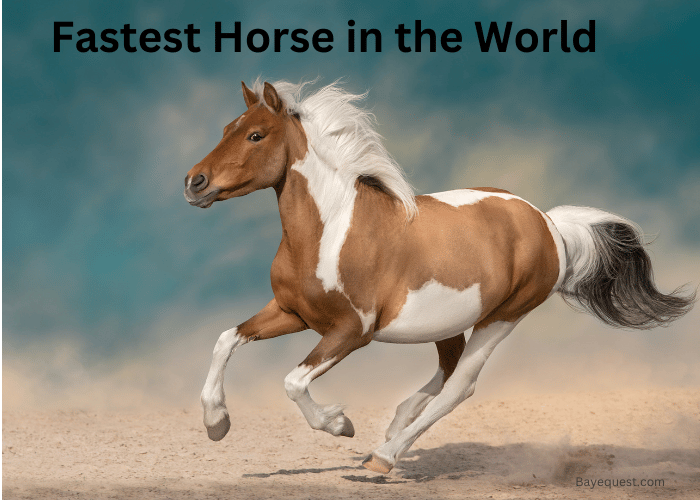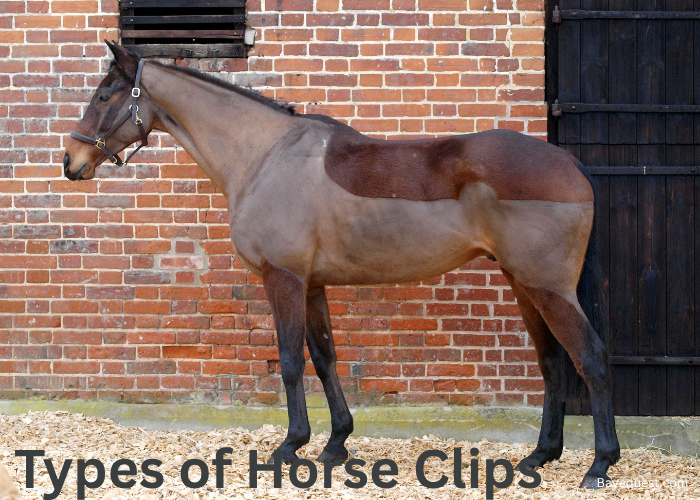Amid thundering hooves and cheering crowds, one champion emerges. Can you imagine the thrill and excitement of witnessing the world’s fastest horse?
This is a tale of power, grace, and blistering speed, spanning from historical dusty tracks to the modern digital age.
It’s more than just records shattered or finish lines crossed. It’s about racing heartbeats, held breaths, and awe-inspiring moments.
Explore the legends, modern heroes, and incredible speed of these magnificent creatures. Welcome to the story of the fastest horse in the world.
What is the Fastest Horse in the World?
When we dive into the world of speed on four legs, one name often races to the front. It’s Winning Brew, a thoroughbred that left jaws on the floor back in 2008.
This horse, a true lightning bolt, set the Guinness World Record for the fastest speed of a racehorse. Hold onto your hats, because Winning Brew blazed through the track at a staggering 43.97 miles per hour.
In the time it takes to blink, she’s already flying past, a blur of power and grace. This record is a testament to what these incredible animals can achieve.
How Fast Can Horses Run?
Horses, those majestic creatures of strength and speed, can fly. Picture this: a horse, muscles rippling, mane flowing, hitting top speeds that can take your breath away.
The average horse speed during a gallop is 25 to 30 miles per hour. That’s fast! But there’s more to know.
When we talk about the crème de la crème, the fastest of the fast, some horses can push the limits even further. We’re talking about racing thoroughbreds, the elite athletes of the equine world.
These speedsters can surge up to speeds of 40 to 45 miles per hour. Yes, you heard that right.
Imagine cruising down the highway, and a horse is keeping pace with you. That’s the kind of speed we’re talking about. Incredible, isn’t it?
Other Fast Horses and Breeds in the World
Winning Brew holds that title for the fastest, but she’s in good company with other legends of speed. Let’s dive into these speedsters:
1. Winning brew
Winning Brew is a legend. She’s not just fast; she’s a record breaker. Imagine this horse, racing down the track.
She hits a speed others dream of, 43.97 miles per hour. This isn’t just any day at the races. It’s a moment where history is made.
Winning Brew shows what Thoroughbreds can do. She’s a testament to training, care, and sheer talent. When we talk speed, her name comes up.
She’s a benchmark for speed. A horse like no other. Winning Brew is racing’s shining star.
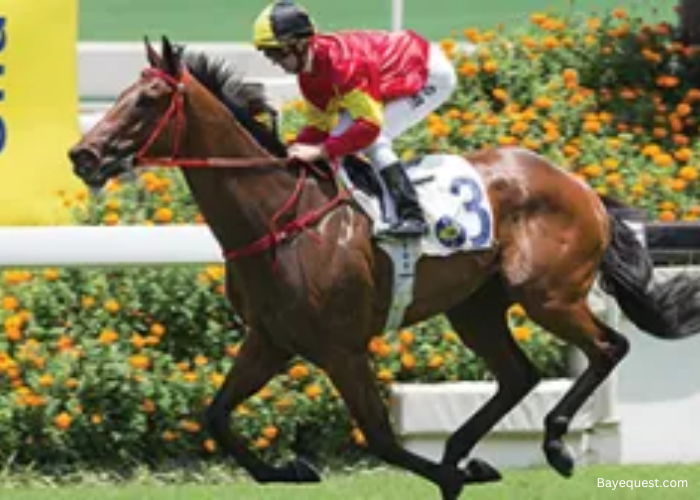
2. Secretariat
Secretariat is a legend. Picture a horse that doesn’t just win but wins by lengths, a lot of them. In 1973, he took the Triple Crown. Not just any win, but history-making.
At the Belmont Stakes, he left others far behind by 31 lengths. His speed? Astonishing. Over the race, he averages more than 37 miles per hour.
Secretariat isn’t just running; he’s flying. His heart is much larger than average, perhaps a key to his unmatched stamina and speed.
He’s not just a horse; he’s a symbol of what greatness looks like. When we talk about the best, Secretariat is always part of the conversation. A true champion, remembered and revered.
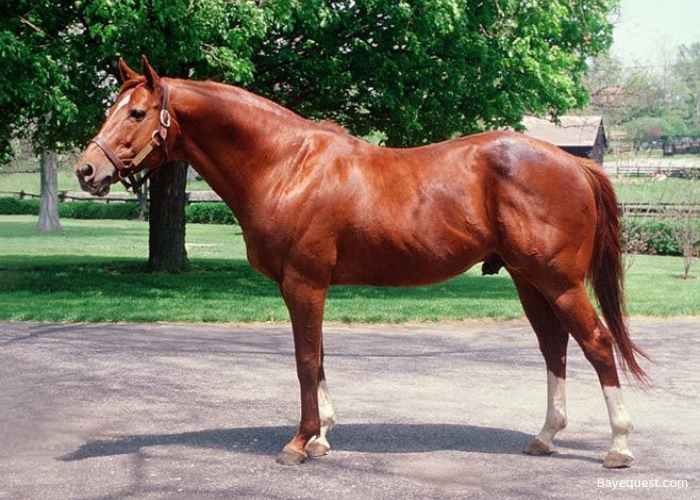
3. Seattle Slew
Seattle Slew is a name that rings with greatness in horse racing. Born to run, he’s a legend. This horse, a champion through and through, clinched the Triple Crown in 1977.
Imagine that – winning the Kentucky Derby, Preakness Stakes, and Belmont Stakes. And he did it undefeated.
That’s right. Seattle Slew raced to the top without a single loss to mar his record at the time of his Triple Crown victory.
His story is one of underdog triumphs. Not just any horse, Seattle Slew was bought for a modest sum, proving that champions can come from anywhere.
On the track, his power, speed, and heart were undeniable. He didn’t just win; he dominated, becoming a symbol of excellence in horse racing.
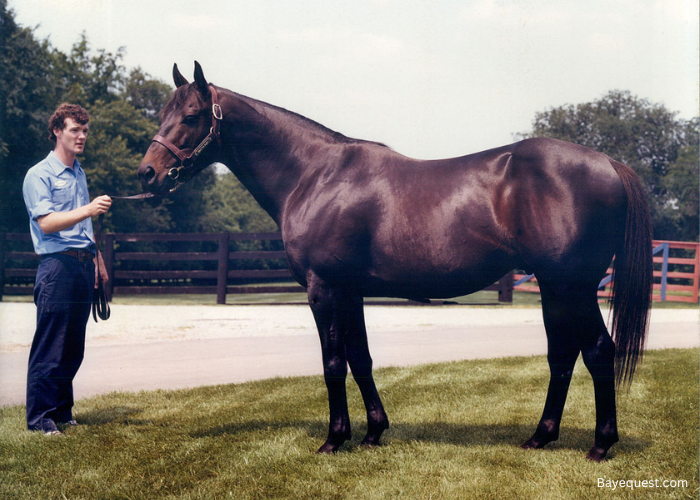
4. Barb
The Barb horse, it’s a story of speed, but in a different way. This breed isn’t just about the racetrack. It’s about endurance, stamina, and the ability to go fast over long distances.
Think of the Barb as the marathon runner of the horse world. Originating from North Africa, these horses are built tough.
They’ve got a history of carrying warriors into battle. That tells you something about their spirit, right?
Barbs are known for their agility and quickness. On a straightaway, they might not outpace a Thoroughbred in a short sprint.
But when it comes to longer distances, rough terrain, they show their strength.
So, when we talk about fast horses, Barbs are in the conversation. But it’s a different kind of fast. It’s about lasting speed. A resilient, enduring kind of fast.
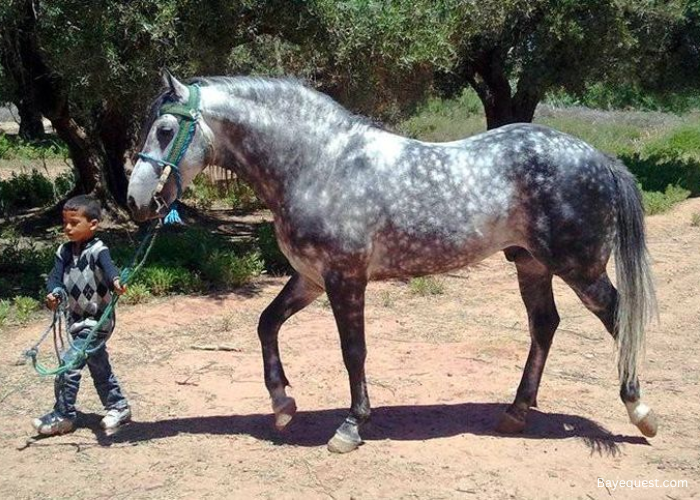
5. Man O’War
Man O’ War, now there’s a name that echoes like thunder through horse racing history. Born in 1917, this chestnut colt wasn’t just fast; he was a force of nature on the racetrack.
Out of 21 races, he won 20. That’s right, only once did he not come in first, and even then, it was a close call.
Man O’ War was more than just speed. He had heart, power, and a stride that seemed to cover the ground like no other. In his time, he set records, some of which stood for decades.
What made Man O’ War a legend was how he won, with a kind of grace and power that left spectators in awe.
After his racing career, he became one of the most influential sires, passing on his exceptional qualities to his offspring.
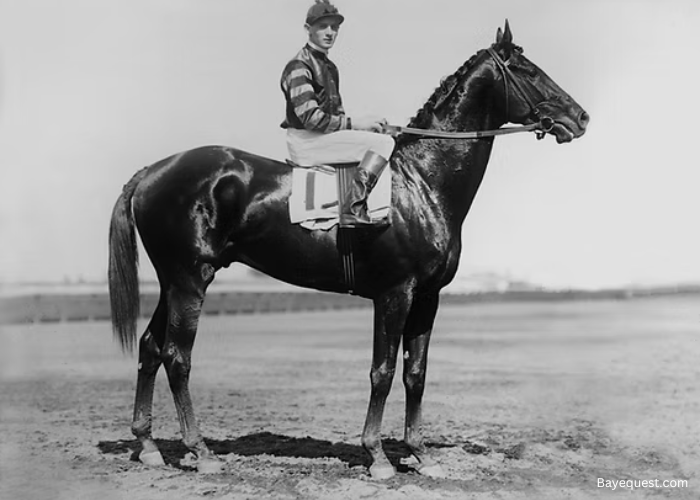
6. Black Caviar
Black Caviar is a tale of sheer brilliance on the track. This Australian sprinting superstar didn’t just run races; she owned them. 25 races, 25 wins! That’s right, unbeaten.
Her speed? Lightning in a bottle. Black Caviar wasn’t just fast; she was a spectacle, making top-class competition look ordinary. Fans didn’t just watch her races; they witnessed history being made.
Black Caviar’s legacy? It’s not just about the wins or the speed. It’s about perfection, achieving what few thought possible. She showed the world what it means to be a champion, time and time again.
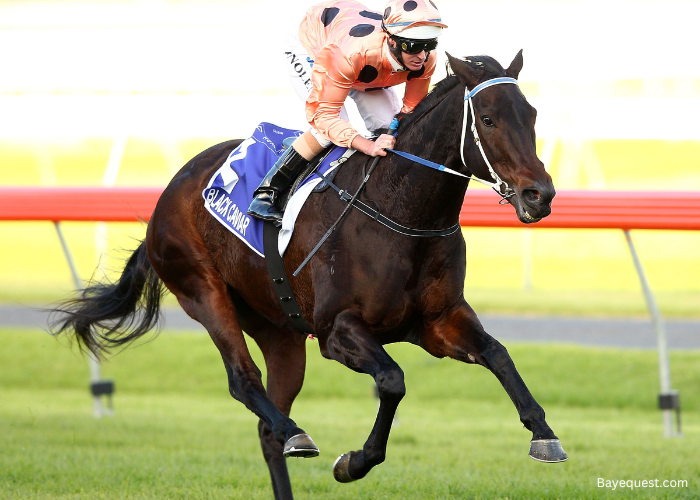
7. American Pharaoh
This is a name that brings to mind a golden era in horse racing. This bay colt didn’t just race. He redefined greatness.
In 2015, he did something no horse had done in 37 years: he won the Triple Crown. That’s the Kentucky Derby, the Preakness Stakes, and the Belmont Stakes, all in a row. A feat so rare.
But he didn’t stop there. American Pharoah went on to clinch the Breeders’ Cup Classic, making him the first horse to secure the Grand Slam of American horse racing. That’s four major wins in one year.
His speed? Exceptional. His heart? Even more so. American Pharoah had this way of running that made difficult races look easy.
He’d pull ahead, creating gaps that seemed impossible to close. Watching him was like watching history in the making, a horse so powerful, so graceful, it was as if he was born to win.
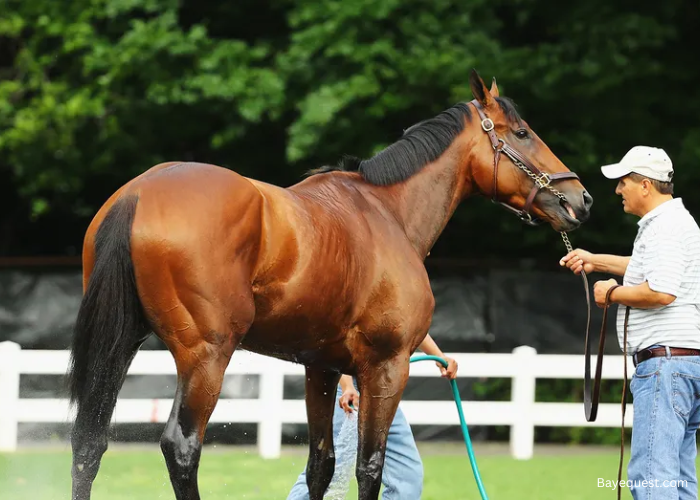
8. Ruffian
Ruffian was a marvel, a filly whose name still stirs the hearts of horse racing fans. Born in 1972, she was black, beautiful, and fast. Very fast.
She won her first race by 15 lengths, but that was just the beginning. She raced, and she won ten times in a row. No horse could catch her. She was unbeaten until her last race.
Her speed was stunning. She set records, one after the other. Every race she ran, she set a new record.
Then came the match race in 1975. Ruffian against Foolish Pleasure, a colt. It was to prove who was faster. It was a big deal.
But tragedy struck. Ruffian broke down. Her right foreleg shattered. She kept running, though. Because that’s who she was. A fighter. But her injury was severe. Despite efforts to save her, she couldn’t be saved.
Ruffian’s legacy is about her spirit and will to run, even when it hurts. She showed what it means to be a champion.
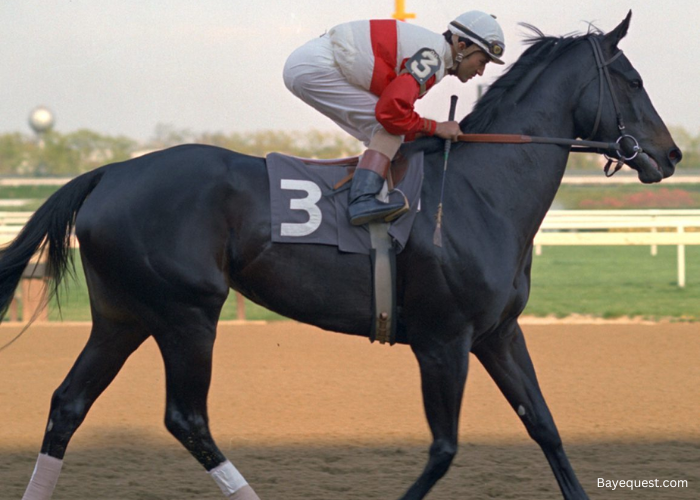
9. The Eclipse
Eclipse was a legend in his own time, and his name has come to symbolize dominance in horse racing. Born during a solar eclipse in 1764, this chestnut stallion wasn’t just fast; he was unbeaten.
Over his racing career, Eclipse won all 18 of his starts, an incredible feat that set him apart from his contemporaries. His speed and strength on the track were unmatched, making him a favorite among racing enthusiasts of his era.
But Eclipse’s impact didn’t end with his racing career. After retiring, he became one of the most influential sires in the history of horse racing.
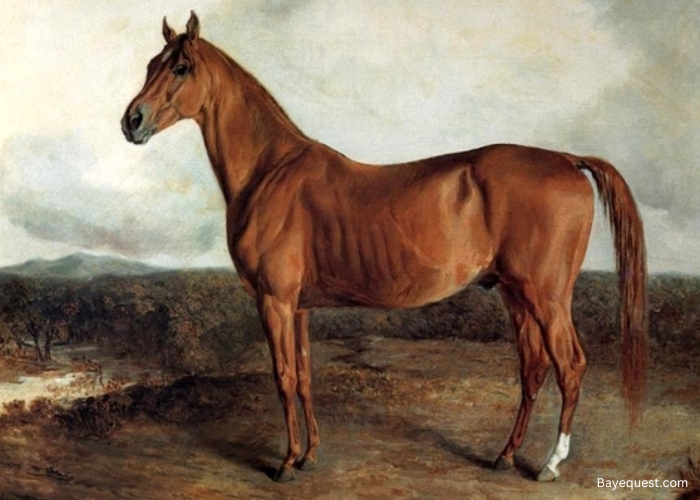
10. Frankel
Frankel, a name that resonates with perfection in the world of horse racing. Born in 2008, this British thoroughbred left an indelible mark on the sport, retiring unbeaten after 14 races.
His career spanned from 2010 to 2012, during which he dominated the field with an aura of invincibility.
From the start, Frankel showed exceptional promise, winning his debut race. Frankel’s crowning moments came in races like the 2000 Guineas, the Queen Elizabeth II Stakes, and the Lockinge Stakes.
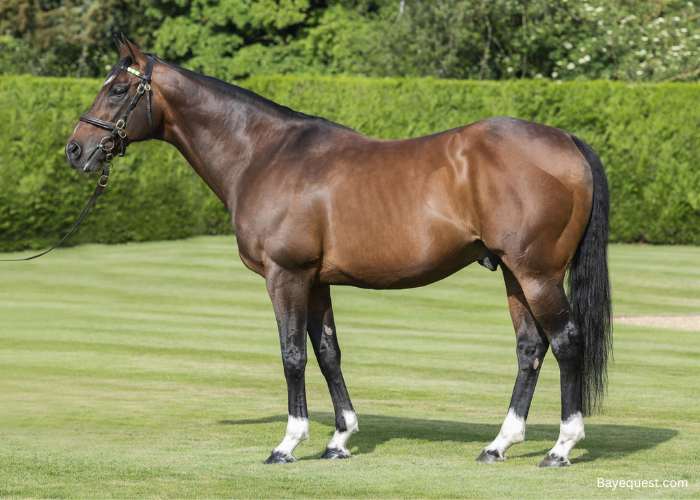
11. Phar Lap
Phar Lap, the chestnut gelding from New Zealand, captured hearts during the early 1930s. Born in 1926, he grew into a racing legend, not just for his speed but for his incredible story of triumph and tragedy.
Phar Lap dominated Australian racing, winning a string of major races that included the Melbourne Cup in 1930.
But Phar Lap was more than a winner. He became a beacon of hope during the Great Depression, a symbol of perseverance and strength.
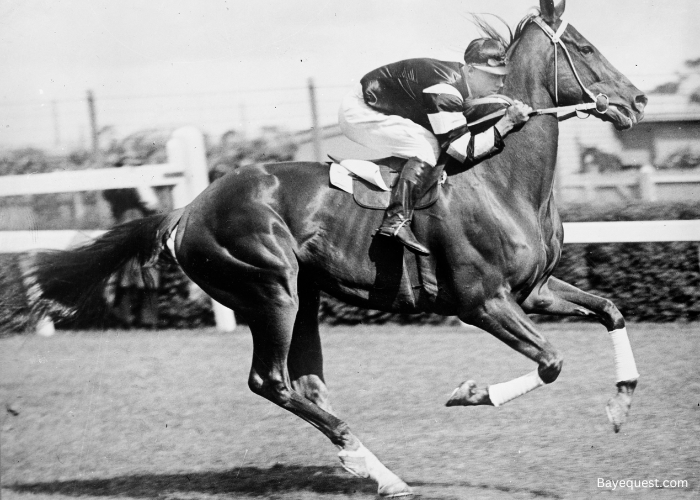
12. Akhal-Teke
The Akhal-Teke, hailing from Turkmenistan, is one of the oldest and most beautiful horse breeds in the world. Known for their endurance and speed, these horses possess a unique metallic sheen to their coat.
Originally bred by the nomadic tribes of Central Asia, the Akhal-Teke was developed for endurance and speed.
This breed is not only celebrated for its beauty but also for its versatility. They have excelled in various equestrian sports, including endurance racing, dressage, and show jumping.
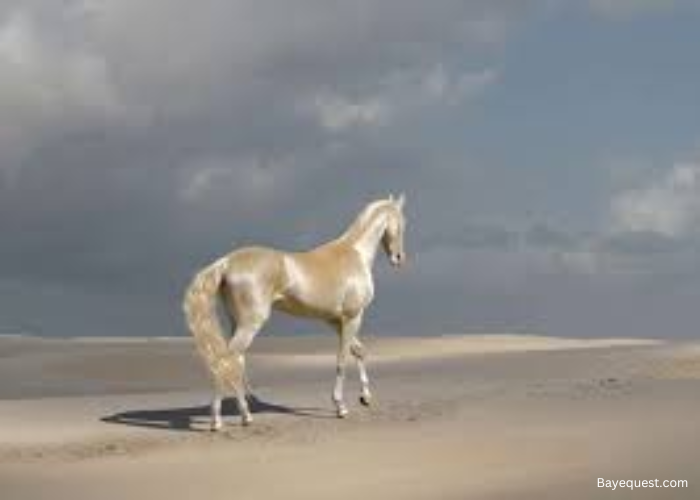
13. American Quarterhorse
The American Quarter Horse is a favorite in the U.S. It’s known for its amazing speed over short distances. This breed comes from a mix of Spanish, English, and native horses from the 17th century.
This horse has a compact, muscular body and a broad chest. It shines in races of a quarter mile or less, hitting speeds up to 55 mph. Its speed, calmness, and smarts make it great for racing and riding.
It’s not just for racing. The American Quarter Horse excels in rodeo events like barrel racing, calf roping, and cutting. It’s also great for western pleasure, trail riding, and ranch work.
People love this breed for more than its athletic skills. It’s also friendly and easy to handle, perfect for all riders.
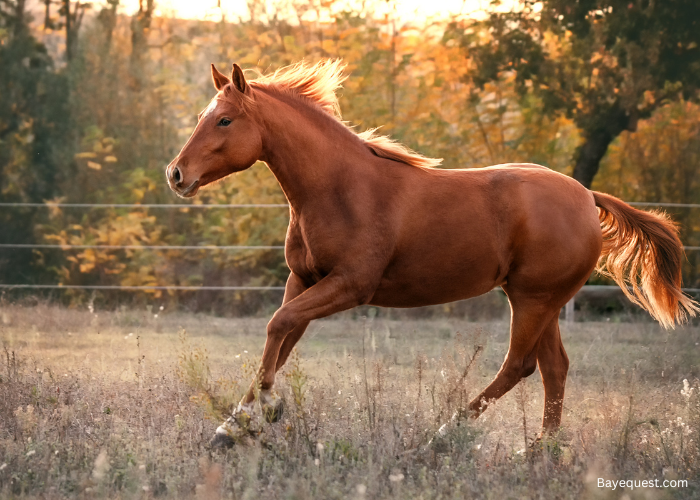
14. Appaloosa
The Appaloosa is a striking horse breed, famous for its colorful spotted coat.
They are medium-sized horses that stand out with their spots, but their coat patterns vary greatly. Some have leopard-like spots all over, while others might have a more blanket-style pattern.
But it’s not just their looks. Appaloosas are known for their versatility. They’re great for riding, ranch work, and even in shows. They’re as tough as they are beautiful, able to handle long rides and rugged landscapes.
These horses are also loved for their temperaments. They’re smart, friendly, and trainable. This makes them great companions, not just for work but for families too.
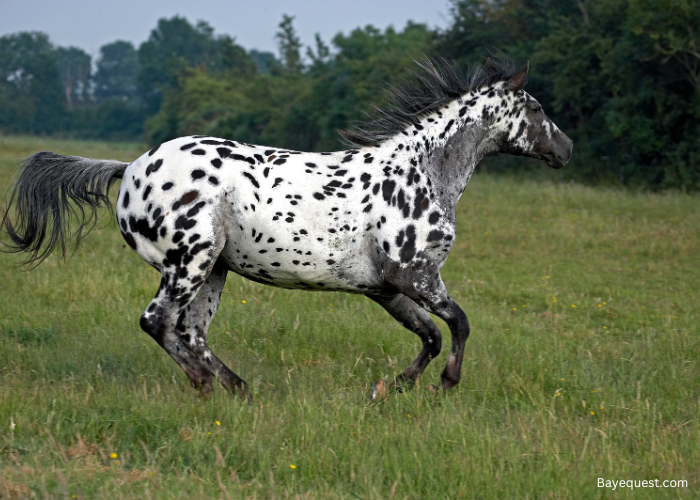
15. Andalusians
The Andalusian horse is a symbol of elegance and grace.
They are medium-sized, strong, and muscular build horses. They usually come in shades of gray and white, but you can find them in other colors too.
What sets Andalusians apart is their movement. They’re famous for their impressive, high-stepping action.
This makes them stars in dressage, a sport that showcases a horse’s training and elegance. They’re also used in other equestrian activities, showing off their versatility and intelligence.
Read also: Thoroughbred Vs Quarter Horse Speed.
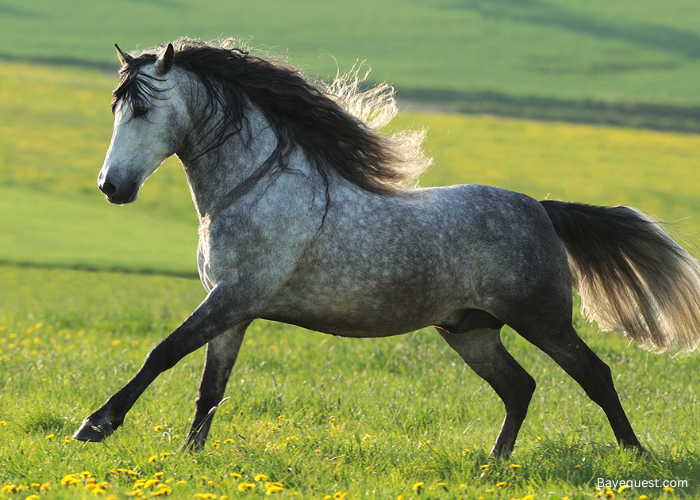
How is Horse Speed Measured?
Measuring a horse’s speed sounds like it could be complex, right? But, it’s pretty straightforward when you break it down. Think of it like timing a sprinter or a car on a track.
Here’s how it goes: Horses run a set distance, and the clock ticks away the seconds. From start to finish, every moment is captured. The key? Distance and time. They tell us the speed.
We use technology, too. Radar guns, like the ones police use to catch speeding cars, can track a horse’s speed in real-time.
And then, there’s GPS. Yes, even horses can go high-tech. GPS trackers can measure their speed, distance, and even how they move on the track.
So, when we talk about a horse galloping at breathtaking speeds, it’s all about how far they’ve gone and how quick they got there. Simple, right?
Interesting read: Best Race Horse of all Time.
Discovering the Speed of Racehorses
When we talk about racehorses and their speed, there’s a lot going on behind the scenes. Let’s break it down.
First up, the genetic edge. Think of it like inheriting a superpower from your parents. Racehorses come from a line of really fast horses. Over time, we’ve gotten good at picking out which horses are likely to produce the fastest kids. It’s all in the genes.
Next, we have physiological superiority. This is a fancy way of saying these horses are built differently. They have big hearts which pump more blood and oxygen to their muscles. Their lungs are huge, letting them take in more air as they run. It’s like having a natural turbo boost.
Training for excellence is where humans come in. Even with all the right physical tools, a racehorse needs to learn how to use them. This is where trainers work their magic. They design workouts that build muscle, increase stamina, and teach the horse how to race smart. It’s a bit like coaching an Olympic athlete.
Lastly, evolution and innovation play a huge part. As we learn more about science and technology, we find new ways to help horses run faster. This can be anything from better training methods to innovations in how we care for them. Think of it as upgrading your car with the latest tech to make it go faster.
So, discovering the speed of racehorses is a mix of nature and nurture, science and tradition. It’s about using everything we know to help these amazing animals reach their full potential.
Read also: Best Horses for Barrel Racing.
The Role of Training and Care in Maximizing Horse Speed
When it comes to making a racehorse fast, training and care are key. Think of it like this: even if you have a sports car, it won’t go fast without the right fuel and a good driver. For racehorses, it’s pretty similar.
Training is about more than just running. It’s about building the horse’s strength, teaching them how to pace themselves, and getting them used to the race environment.
A good trainer can push a horse just enough to improve without overdoing it. It’s like having a personal coach who knows exactly what workout you need.
Care is equally important. Imagine trying to run a marathon on no sleep and junk food. You wouldn’t get very far.
For horses, good care means the right diet, plenty of rest, and medical attention when needed. It’s all about making sure the horse is healthy and happy. A well-cared-for horse is a fast horse.
Together, training and care help a racehorse reach its full speed potential. It’s not just about having a fast horse; it’s about making a horse fast through hard work, smart planning, and care. That’s the secret to winning races.
FAQ
Who is faster, Secretariat or Phar Lap?
Comparing the speed of Secretariat and Phar Lap is challenging due to the differences in eras, track conditions, and competition. However, Secretariat is celebrated for his record-breaking times in the Triple Crown races. Phar Lap dominated Australian racing with remarkable endurance and speed but didn’t have the same opportunity to set widely recognized time records.
Can the weight a horse carries affect its racing speed?
Yes, the weight a horse carries can significantly affect its racing speed. Additional weight can slow a horse down, making it harder to maintain top speed over a race’s duration.
How does the racing surface impact a horse’s performance?
The racing surface plays a crucial role in a horse’s performance. Different surfaces, like turf, dirt, or synthetic tracks, can affect how a horse runs, its speed, and even its risk of injury. Some horses perform better on certain surfaces due to their training, physical characteristics, or preferences. The surface impacts the horse’s traction, stride, and overall racing strategy.
Conclusion
Exploring the world’s fastest horses unveils a saga of speed, from Secretariat’s legendary strides to Winning Brew’s record-breaking pace. Beyond mere velocity, it’s a tale woven with genetics, care, and the art of training.
The quest reveals that speed, while thrilling, is but one facet of equine greatness. It’s their heart, resilience, and the excitement they stir in us that etch their names in history.
As we delve into what makes a horse fast, we find a deeper appreciation for the sport itself.




